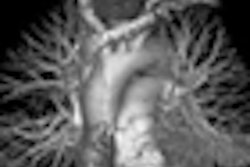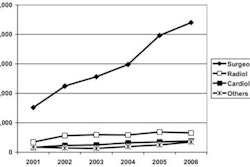Even at very high doses, gadolinium-based contrast agents alone are not sufficient to cause nephrogenic systemic fibrosis (NSF) in patients with kidney problems, and there are ways to diminish the likelihood of NSF occurring to nearly zero.
Those conclusions come from a study conducted at the Mayo Clinic in Jacksonville, FL, the results of which were published in the June issue of the American Journal of Roentgenology (June 2009, Vol. 192:6, pp. 1538-1543).
NSF is a debilitating and occasionally fatal disease that can include fibrosis of the bone, kidneys, lungs, muscle, myocardium, pericardium, pleura, skeletal muscle, and testes.
"You can say that gadolinium is required to develop NSF, but, in and of itself, it is not sufficient. It requires cofactors," said lead author Dr. Mellena Bridges. "You will not see NSF without gadolinium. It is required, but it is not sufficient, and there are ways to diminish the likelihood of [NSF] happening to nearly zero."
Enrollment criteria
Mayo researchers reviewed the facility's database of the radiology reports from January 2002 to December 2005 to find patients who had received an intravenous dose of at least 40 mL of gadodiamide (Omniscan, GE Healthcare, Chalfont St. Giles, U.K.) during a single imaging session for catheter angiography or CT.
The study excluded gadolinium injections for MRI or MR angiography, citing the lack of documentation in the MRI department and "because we never went over 40 [mL] for MR," Bridges said. "We really wanted to look at those [cases] over 40 mL."
Regarding inclusion criteria, a patient's estimated glomerular filtration rate (GFR) values were obtained within two days before contrast administration and were less than 60 mL/min/1.73 m2. Second, at least 40 mL of gadodiamide (287 mg/mL [0.5 mol/L] of gadodiamide dimeglumine) was administered. And, third, the patient must have undergone clinical follow-up for at least one year after administration of the contrast agent.
The final count was 61 patients, with a median age of 65 years (range, 23-88 years), who had their clinical and laboratory data reviewed at least one month before contrast administration to a minimum of one-year follow-up.
Patient dosage
All 61 patients received 40 to 200 mL of gadodiamide, with a median dose of 80 mL. Twenty-six patients (43%) received additional gadodiamide for imaging within two weeks of the high-dose administration. Seven of 61 injections (11%) were made within 24 hours of the high-dose administration. In that subgroup, additional doses ranged from approximately 18 to 80 mL, with 160 mL as the largest total 24-hour dose.
Only one of the 61 patients enrolled in the study was diagnosed with NSF within one year of gadolinium-based contrast injection, making the prevalence of NSF 1.6% in this high-dose, variable-risk group.
The 58-year-old male was undergoing long-term hemodialysis and dialysis due to end-stage diabetic vasculopathy. He also was under evaluation for combined renal-pancreatic transplantation when he received gadodiamide. The authors noted that his comorbid conditions included obesity, a history of heavy smoking, chronic pancreatitis, diabetic retinopathy and neuropathy, myocardial infarction, and back problems.
Contributing factors
The NSF diagnosis was made within six weeks of a 50-mL gadodiamide administration for upper extremity venography and associated stenting. In the three months immediately preceding this administration, the patient had undergone three MRI examinations with a total additional exposure of approximately 100 mL of gadodiamide.
The authors cited one study limitation as the "heterogeneous, clinically labile nature of our patient sample. Control for other potentially nephrotoxic or nephroprotective variables was impossible, especially because most of the patients had multiple and serious comorbid conditions."
The final results, the study notes, suggest "at least this particular gadolinium chelate, if not the whole class of gadolinium-based contrast agents, does not pose a substantial clinical challenge to renal function."
Although a gadolinium-based contrast agent "may function as a necessary trigger of NSF or nephrogenic fibrosing dermopathy," the authors wrote, "it is not a sufficient cause for development of the disease, even at high doses. Moreover, clinically relevant nephrotoxicity of gadodiamide is not found in patients with moderate to severe renal insufficiency."
Mayo's protocol
"What our study has taught us is that it's not easy to cause NSF," Bridges said. "That was one of the questions we had: How many patients do we have out there that we don't even know about who have this horrible disease? It was very heartening to see how difficult it is" to cause NSF.
The study results reinforced Mayo's existing protocols regarding the administration of a gadolinium-based contrast agent. The facility continues to ask all patients whether they have had any problems with renal function, especially if they are kidney transplant candidates or have had a transplant.
If there is no history of renal issues, Mayo will use the gadolinium-based contrast agent. If there are renal issues, Mayo requires that outpatients have a GFR evaluation within five days of their scan and inpatients within two days.
By Wayne Forrest
AuntMinnie.com staff writer
July 8, 2009
Related Reading
JHU study: Screening patients prior to MRI lowers NSF risk, February 4, 2009
ACR committee works toward gadolinium-based contrast policy, October 24, 2008
Hemodialysis helps prevent NSF in some patients, study finds, August 19, 2008
Incidence of nephrogenic systemic fibrosis varies with contrast agents, July 24, 2008
Study questions some NSF risk factors, April 15, 2008
Copyright © 2009 AuntMinnie.com



















